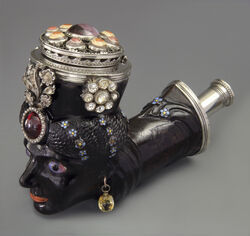Oriental with jewels
March 2022

In our time when hypersensitivity about skin color is emphasized again and again, it is better not to show yourself with the depicted pipe. At the time it was different, then it was a great eye-catcher and everything is done to heighten the effect. Shortly after 1800 when this pipe was made, artificial meerschaum was a new and special material. Because this paste does not have the most ideal color, it was finished with a glossy black dye. Thus this Oriental woman took on the appearance of a negress. Everything from the Levant was popular with the turban as the most iconic symbol that was often depicted. The curious combination of Eastern and African makes the pipe even more exotic. The mysterious material could also have been seen as black lacquer at the time, with the rare shine of unknown Japan. Yet the portrait head is not modeled very finely, the stem is too heavy, the ornament at the stem end is a mushy rocaille and the surprizing upturned nose does not fit well with an Oriental. Most striking, however, is the finery. No effort has been spared in lifting up the pipe to a valuable item. The eyes are made of moonstone in a silver setting and the lips are made of real coral. The earrings are cut topazes hanging from a gold mounting. The pin on the front shows a large wine red stone set in a frame of transparent sparkles while the plume is set with brilliant cut glitter stones. On both sides of the pipe bowl we see the same silver mount in rosette shape, also with sparkling stones. Of a different order is the silver lid that contains eight cabochon cut stones at the top with a ninth much larger one in the middle. They are beautiful multicolored stones in an attractive variation. The silver surface allowing the air flow has been sawn open in filigree and even has a large decorative stone inside. However, it is not all gold that glitters. The settings may look like platinum but they are not and the brilliant cut stones sparkle that it is a delight but they are not diamonds but cut quartz. Nevertheless, the smoker who bought this pipe will have made a good impression by showing himself with such a glistening pipe. Especially because this pipe bowl was mounted on a flexible stem of braided silver wire. We do not know the origin of this vanity and vainglory. It may well have been in Russia, since the only known variant is in the Hermitage in Saint Petersburg.
Amsterdam Pipe Museum APM 24.437
Permalink